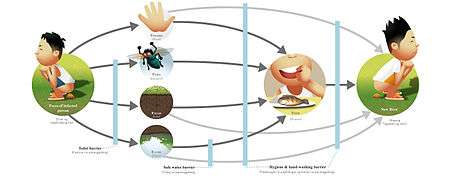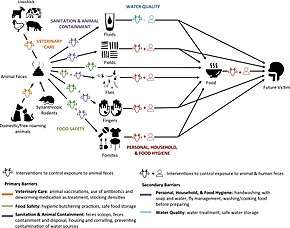Fecal–oral route
The fecal–oral route (also called the oral–fecal route or orofecal route) describes a particular route of transmission of a disease wherein pathogens in fecal particles pass from one person to the mouth of another person. Main causes of fecal–oral disease transmission include lack of adequate sanitation (leading to open defecation), and poor hygiene practices. If soil or water bodies are polluted with fecal material, humans can be infected with waterborne diseases or soil-transmitted diseases. Fecal contamination of food is another form of fecal-oral transmission. Washing hands properly after changing a baby's diaper or after performing anal hygiene can prevent foodborne illness from spreading.

The common factors in the fecal-oral route can be summarized as five Fs: fingers, flies, fields, fluids, and food. Analingus, the sexual practice of licking or inserting the tongue into the anus of a partner, is another route. Diseases caused by fecal-oral transmission include diarrhea, typhoid, cholera, polio and hepatitis.
Background
.jpg)
F-Diagram
The foundations for the "F-diagram" being used today were laid down in a publication by WHO in 1958.[1] This publication explained transmission routes and barriers to the transmission of diseases from the focal point of human feces.
Modifications have been made over the course of history to derive modern-looking F-diagrams. These diagrams are used in many sanitation publications.[2] They are set up in a way that fecal–oral transmission pathways are shown to take place via water, hands, arthropods and soil. To make it easier to remember, words starting with the letter "F" are used for each of these pathways, namely fluids, fingers, flies, food, fields, fomites (objects and household surfaces).
Rather than only concentrating on human feces, animal feces should also be included in the F-diagram.[2]
The sanitation and hygiene barriers when placed correctly prevent the transmission of an infection through hands, water and food. The F-diagram can be used to show how proper sanitation (in particular toilets, hygiene, handwashing) can act as an effective barrier to stop transmission of diseases via fecal–oral pathways.
Examples
Transmission
The process of transmission may be simple or involve multiple steps. Some examples of routes of fecal–oral transmission include:
- water that has come in contact with feces (for example due to groundwater pollution from pit latrines) and is then not treated properly before drinking;
- by shaking someone's hand that has been contaminated by stool, changing a child's diapers, working in the garden or dealing with livestock or house pets.
- food that has been prepared in the presence of fecal matter;
- disease vectors, like houseflies, spreading contamination from inadequate fecal disposal such as open defecation;
- poor or absent hand washing after using the toilet or handling feces (such as changing diapers)
- poor or absent cleaning of anything that has been in contact with feces;
- sexual practices that may involve oral contact with feces, such as anilingus, coprophilia or "ass to mouth".
- eating feces, in children, or in a mental disorder called coprophagia
- eating soil (geophagia)
Prevention

One approach to changing people's behaviors and stopping open defecation is the community-led total sanitation approach. In this process "live demonstrations" of flies moving from food to fresh human feces and back are used. This can "trigger" villagers into action.[3]
Diseases
The list below shows the main diseases that can be passed via the fecal–oral route. They are grouped by the type of pathogen involved in disease transmission.
Bacteria
Viruses
- Hepatitis A[9]
- Hepatitis E[10]
- Enteroviruses
- Norovirus acute gastroenteritis
- Poliovirus (poliomyelitis)
- Rotavirus[7] – Most of these pathogens cause gastroenteritis.
Protozoans
Helminths
- Tape worms[7]
- Ascariasis and other soil transmitted helminthiasis
Related diseases groupings
Waterborne diseases are diseases caused by pathogenic microorganisms that most commonly are transmitted in contaminated fresh water. This is one particular type of fecal-oral transmission.
Neglected tropical diseases also contains many diseases transmitted via the fecal-oral route.
See also
References
- Wagner, E. G., and Lanoix, L. N. (1958). Excreta disposal for rural and small communities (PDF). WHO, Geneva, Switzerland. p. 12.
- Penakalapati, Gauthami; Swarthout, Jenna; Delahoy, Miranda J.; McAliley, Lydia; Wodnik, Breanna; Levy, Karen; Freeman, Matthew C. (2017-10-17). "Exposure to Animal Feces and Human Health: A Systematic Review and Proposed Research Priorities". Environmental Science & Technology. 51 (20): 11537–11552. doi:10.1021/acs.est.7b02811. ISSN 0013-936X. PMC 5647569. PMID 28926696.
- Kal, K and Chambers, R (2008) Handbook on Community-led Total Sanitation Archived 2015-04-10 at the Wayback Machine, Plan UK Accessed 2015-02-26
- Hale TL, Keusch GT (1996). Baron S, et al. (eds.). Shigella in: Baron's Medical Microbiology (4th ed.). Univ of Texas Medical Branch. ISBN 978-0-9631172-1-2. (via NCBI Bookshelf).
- Giannella RA (1996). Baron S; et al. (eds.). Salmonella:Epidemiology in: Baron's Medical Microbiology (4th ed.). Univ of Texas Medical Branch. ISBN 978-0-9631172-1-2. (via NCBI Bookshelf).
- Finkelstein RA (1996). Baron S; et al. (eds.). Cholera, Vibrio cholerae O1 and O139, and Other Pathogenic Vibrios in: Baron's Medical Microbiology (4th ed.). Univ of Texas Medical Branch. ISBN 978-0-9631172-1-2. (via NCBI Bookshelf).
- Intestinal Parasites and Infection Archived 2010-10-28 at the Wayback Machine fungusfocus.com – Retrieved on 2010-01-21
- "Stool-To-Mouth or Fecal–Oral Route of Transmission of Infection | Healthhype.com". www.healthhype.com. Retrieved 2016-04-18.
- Zuckerman AJ (1996). Baron S; et al. (eds.). Hepatitis Viruses in: Baron's Medical Microbiology (4th ed.). Univ of Texas Medical Branch. ISBN 978-0-9631172-1-2. (via NCBI Bookshelf).
- Wang L, Zhuang H (2004). "Hepatitis E: an overview and recent advances in vaccine research". World J Gastroenterol. 10 (15): 2157–62. doi:10.3748/wjg.v10.i15.2157. PMC 4724990. PMID 15259057.
- Meyer EA (1996). Baron S; et al. (eds.). Other Intestinal Protozoa and Trichomonas Vaginalis in: Baron's Medical Microbiology (4th ed.). Univ of Texas Medical Branch. ISBN 978-0-9631172-1-2. (via NCBI Bookshelf).